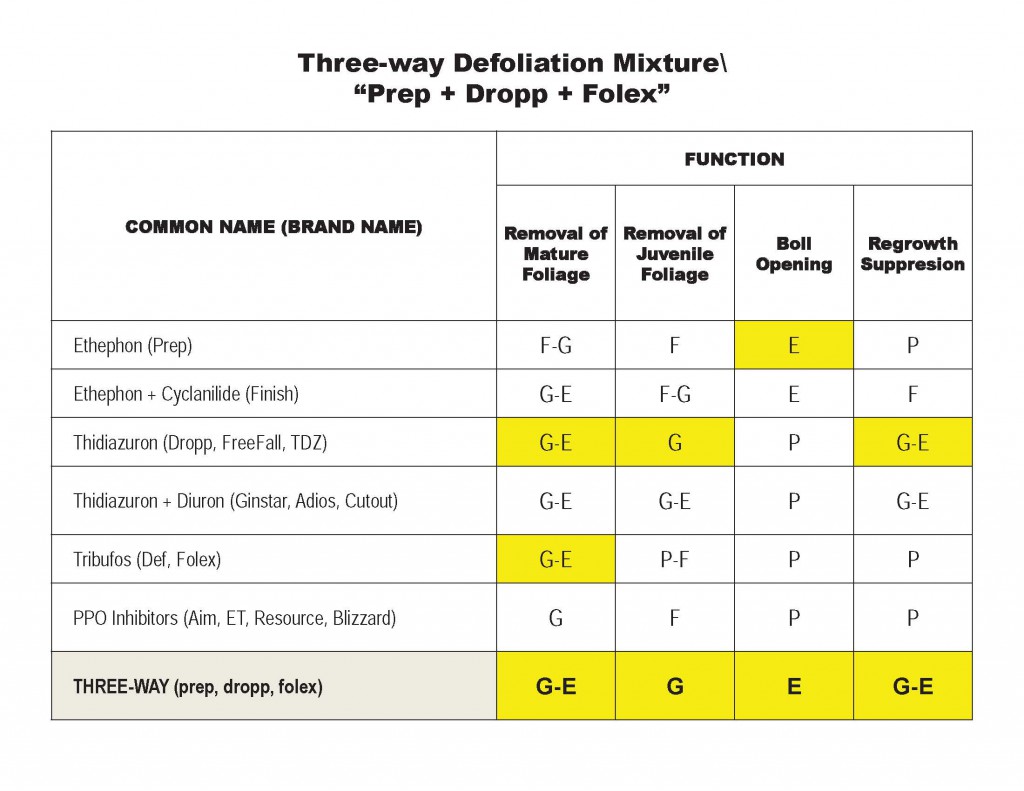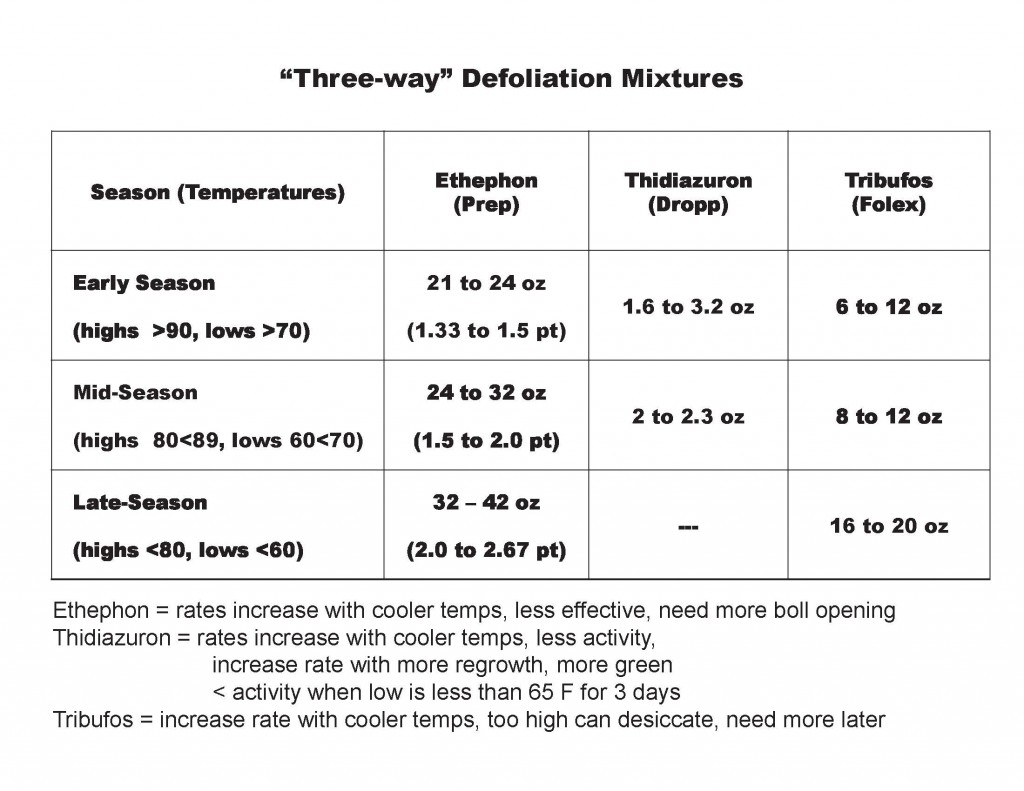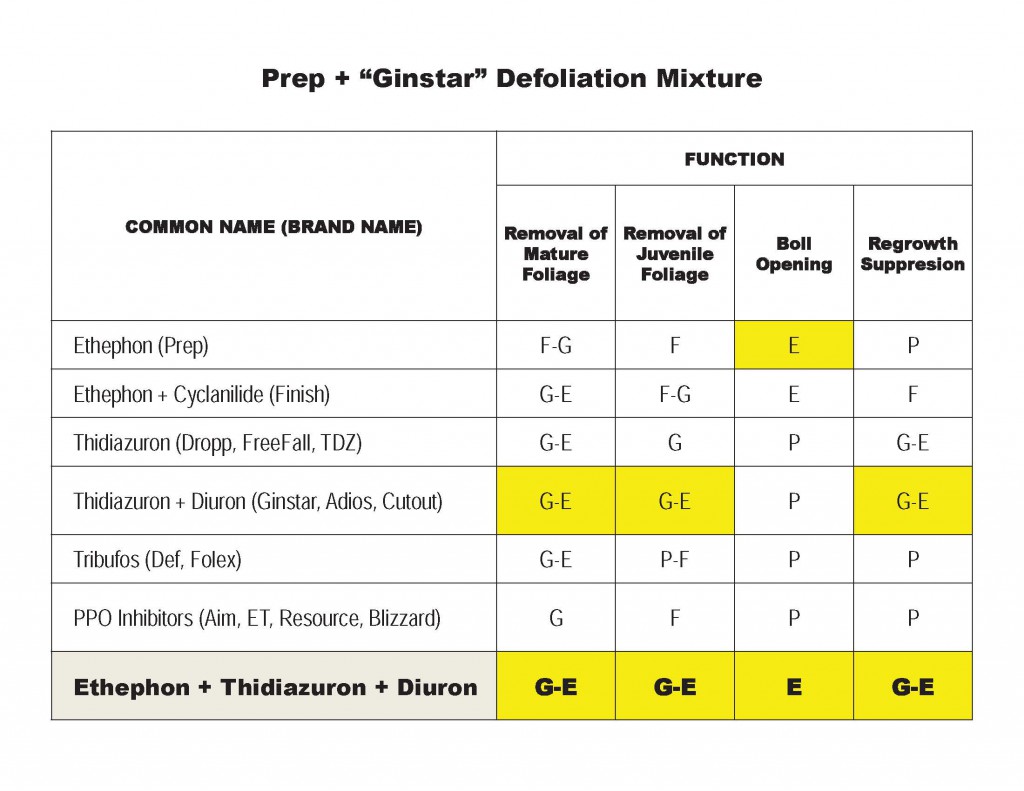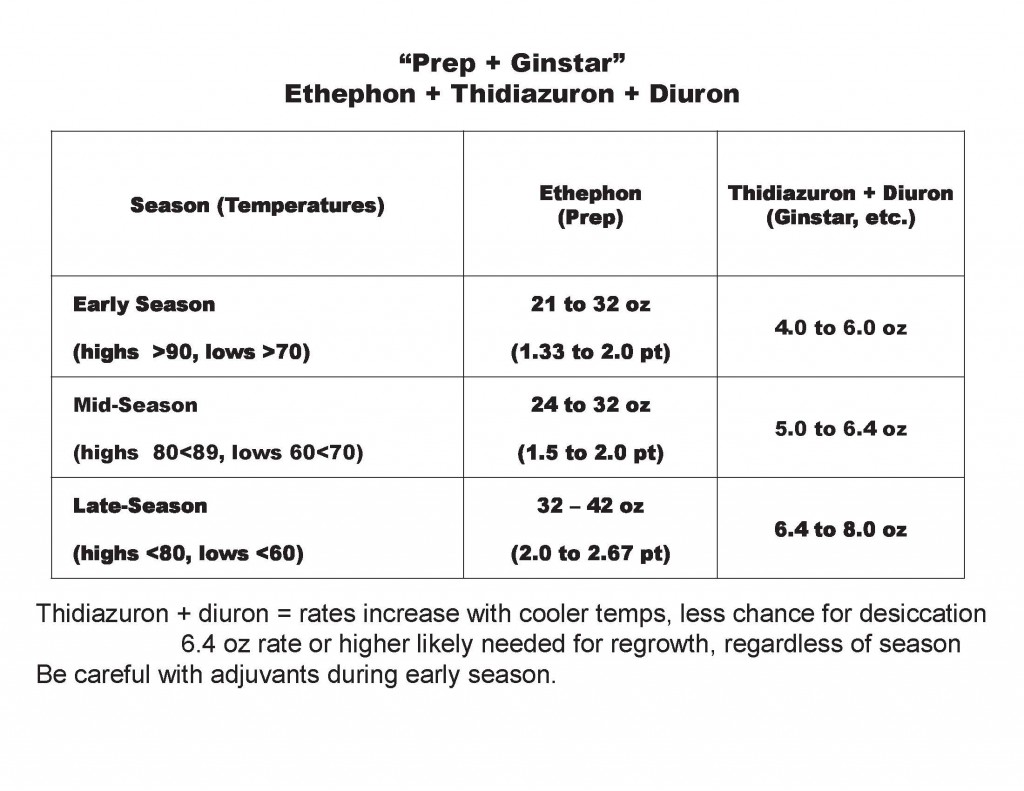Timing of cotton defoliant application can be determined in many ways. Research in Georgia has clearly shown defoliation application should be made when 60 to 75% of the bolls on the plant are open. Whether one should lean towards 60 or 75% depends upon how uniform the crop is, as a plant that grown under optimum conditions can often be defoliated earlier than one that has gone through periods of stress. In any situation, it is almost always most profitable to defoliate the crop when the crop reaches 75% open boll.
The process of actually determining open boll percentages can be quite time consuming considering that multiple plants in each field should be assessed (and averaged) and this process should be conducted for each field separately. Therefore, there is another method to determine proper defoliation timing which is much quicker and easier. This process involves counting the number of main-stem nodes between the uppermost first position cracked boll and the uppermost first position boll we want to harvest (in some cases there are late set bolls which will not have time to mature that are set in the top of the canopy). With this method in Georgia we consider it is most profitable to defoliate the crop when it reaches 3 to 4 nodes above cracked boll (NACB).
Another method, which can be used in conjunction with determining open boll % and counting NACB is the “sharp knife technique.” This method involves using a knife to cut the bolls in half so that you can see the cross section. A harvestable boll should have lint that strings out as you cut it and the cotton seed should have a darkened seed coat with developed cotelydons. When we say “harvestable” we mean that the boll should be able to be opened with the use of an ethephon product. In some cases, we use this method to determine the uppermost harvestable boll when figuring NACB.
In general, the best way to determine proper defoliation timing is to employ a combination of these methods. A proper timing of defoliation is the first step to a successful harvest. We should point out that most producers could defoliate their crop earlier than they typically do. In Georgia, we have always had to balance peanut digging in with cotton harvest and cotton is typically much more forgiving than peanut when it comes to harvest timing. However, we should make an effort to defoliate the crop when it is ready, as delays in defoliation applications can turn into lost profit. Specifically, delays in defoliation relate into delays in harvest and those delays often turn into lost yield and fiber quality.
Defoliation of a cotton plant can impact it in four ways. We consider those four functions to be (1) removal of mature leaves, (2) removal of juvenile leaves and plant tissue, (3) preventing regrowth of new leaves after defoliant application and prior to harvest, and (4) opening bolls. A particular cotton crop may need a defoliant application to impact one or more, typically all four, of these functions. Since one product is not effective on all of these functions, tank mixtures of products are applied to enhance the overall effect of the application. Product selection and application rates are determined by the condition of the crop (which functions need to happen) and condition of the environment (temperature, rainfall forecast, soil fertility, etc.).
Additional Comments:
- Application water volume and pressure greatly impact overall performance. Often, these two factors are as if not more important than choosing which products and what rates to utilize. One should apply at least 15 GPA when using ground rigs (the more the better, 20 GPA is better than 15 and 25 is better than 20, etc.) and as much water volume as possible with aerial applications. Aerial applications can be extremely effective when products are applied such that spray is blown into the canopy.
- Follow product labels concerning the addition of additives. Additives may aid in uptake of some hormonal defoliants but may also increase the chances of leaf desiccation when combined with others especially with high temperatures. In general, when tribufos (Def) is used in the mixture, additives are not needed to improve efficacy.
- Rainfastness is always a concern with all products however thidiazuron requires a 24 hour rainfree period. However, when thidiazuron is used with other products (especially when mixed with tribufos) the actual rain-free period is reduced. If rainfall occurs before the rain-free period is reached, we suggest that you wait about 7 days and evaluate effectiveness and then make decisions on follow-up applications.
A few comments on cotton defoliation in 2018 with a limited supply of Thidiazuron
Many around the state are concerned about the limited availability of thidiazuron and how that will affect cotton defoliation in 2018. Thidiazuron (TDZ) is a key component of many cotton defoliation tank mix and is excellent at preventing regrowth after defoliation. Below are our thoughts and suggestions on the issue.
- First, go ahead and make plans with regards TDZ for this growing season. In general we vary rates of TDZ based on weather, potential for regrowth and amount of juvenile tissue present at defoliation. If one were to use the three-way on their entire crop, they could budget around 2.5 to 3.0 oz of TDZ per acre of cotton and vary rates in particular situations. With a significant portion of the state’s crop being planted after June 1, a lot of our cotton will be defoliated when conditions are cool enough where regrowth will be less of an issue.
- Logistics – Be timely when defoliating and harvesting. Try to defoliate only what you will be able to harvest quickly and try not to leave cotton in the field for extended periods of time which will allow for regrowth to occur. Without TDZ, regrowth will certainly be much more of an issue in some cases and harvesting quicker after defoliation can limit the impact of regrowth and cotton quality.
- Use proper rate for conditions – since TDZ does not cause leaf desiccation, producers can use higher rates in some places compared to others and get more out of the TDZ we have. Typically, we would suggest using more early during the defoliation season and where more green tissue is present (3 to 4 oz/A on the high end and 1.5 to 2.5 on the low end). When temperatures drop into the lower 60’s at night for several consecutive days the overall effectiveness of TDZ is limited and we could drop it out of the three-way mix.
- Calibrating equipment and use proper GPAs – Make sure your equipment calibration is correct. You may be applying more product than you think. Be sure to use as much water and pressure as possible to get more out of the TDZ that you apply. Defoliants are typically not mobile in the plant and to prevent regrowth TDZ should actually hit the part of the plant where regrowth occurs.
- The three-way is our typical standard for cotton defoliation in Georgia. If TDZ becomes unavailable, the next most effective option is usually ethephon and “Ginstar” (a pre-mix of thidiazuron + diuron). This application can be an extremely comparable option in most situations.
- Lower rates for lower regrowth potential – If all else fails and you cannot get the full rates of needed product, you should evaluate individual fields for their potential for regrowth. There are many factors that contribute to juvenile regrowth after defoliation but fields that are at the highest risk would be high fertility fields that experienced a premature cutout due to drought stress followed by good soil moisture and warm weather at the time of defoliation and after. These crops still have some “horsepower” left and will likely need a full rate. Fields that are at the lowest risk for regrowth are fields that have a heavy boll load, used all of its available nitrogen, and have begun naturally senescing leaves. These are fields that may only require a reduced rate of TDZ.
- So, in general our suggestions are:
- Use the TDZ you have wisely, if regrowth potential is low then consider rates between 1.5 to 2.0 oz/A, if regrowth is expected and there is a lot of juvenile tissue is present consider higher rates between 3.0 to 4.0 oz/A
- If no TDZ is available, mixtures of ethephon + Ginstar (TDZ + diuron) can be very effective at removing juvenile tissue and preventing regrowth. An 8 oz/A rate of the Ginstar products has 2.0 oz of TDZ (a 4 lb ai/A TDZ product) and 1.0 oz of diuron (4 lb ai/A diuron product)
- If TDZ isn’t available and Ginstar products are not used, be aware that regrowth can be more troublesome and harvest as timely as possible.
- If no TDZ is available and regrowth potential is lower, then the mixture of ethephon + tribufos (Folex) can be very effective.
- Mixtures of ethephon + PPO herbicides (ET, Aim, Display, etc.) can also be effective. However, these mixtures are sometimes less consistent than mixtures of ethephon + tribufos (Folex) and in general are more consistent later in the defoliation window.



